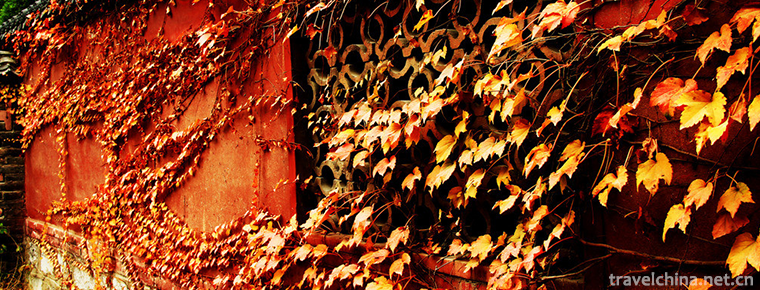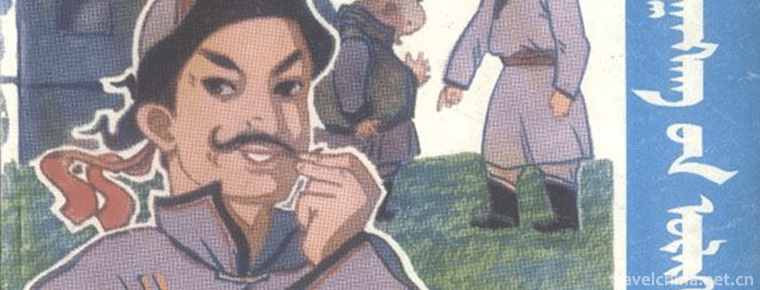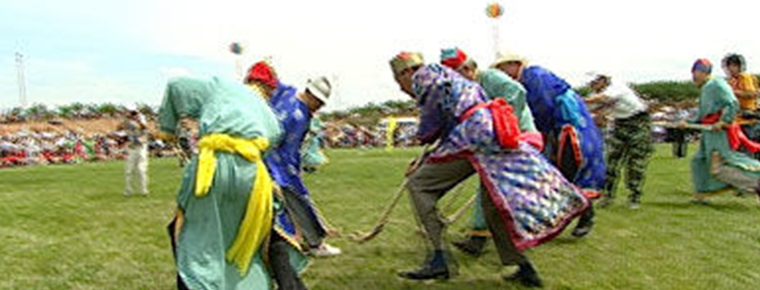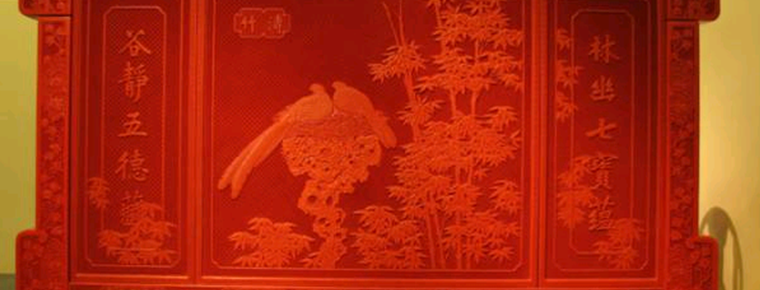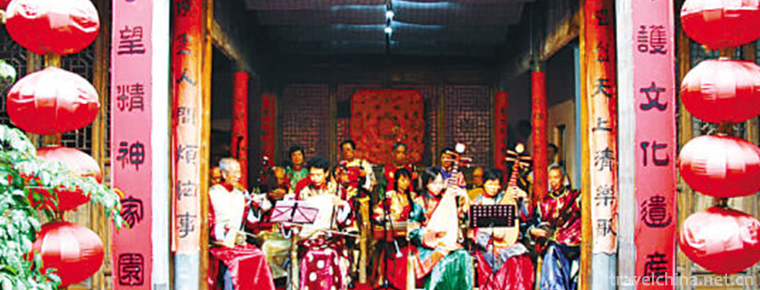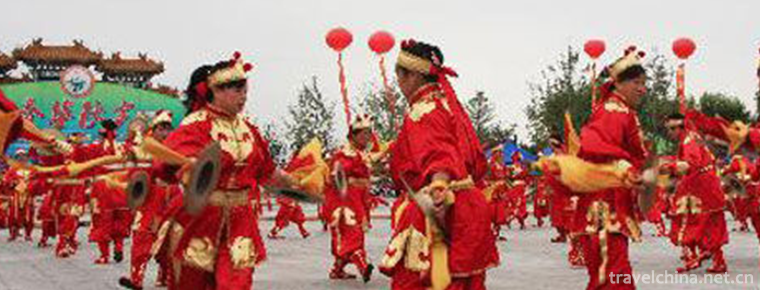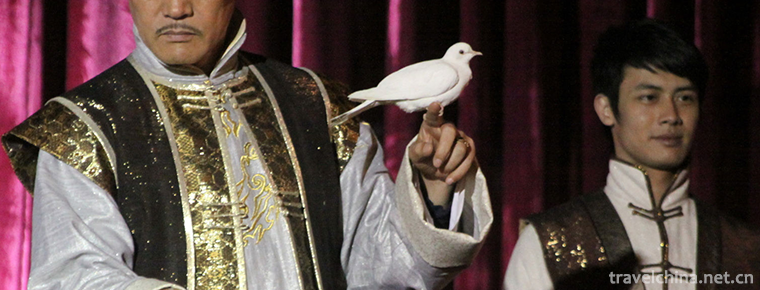Chord cavity
Chord cavity
Based on Pingli dialect in Ankang City, Shaanxi Province, there are 13 singing patterns, including 8 commonly used tunes, 18 suona tunes and 30 gongs and drums. Pingli string is a complete set of local operas, which is composed of tune music, vocal tune, mode, slate, playing cards, leading and singing.
The rap of string tune, the "chanting chant" followed by the interaction of the audience at the end of each aria, and the stringed Hu and "lotus flower fall" in musical instruments are three distinct personality characteristics of string tune which are different from other operas.
On May 23, 2011, the "string tune" declared by Pingli County of Shaanxi Province was listed in the third batch of national intangible cultural heritage list with the approval of the State Council.
historical origin
Pingli string tune, also known as string opera, is named for its main performance of string hu. Music belongs to plate tune. Since the emergence of Jiaqing in Qing Dynasty, Pingli County has been the center of activities in Ankang, Xunyang, Langao, Zhenping, Baihe and Fangzhu areas of Hubei Province. More than 800 plays have been preserved.
The development and evolution of Xiangzi Tune has gone through three stages: from the end of Jiaqing to the beginning of Daoguang, the formation stage of Xiangzi Tune. In 1819 A.D. (Jiaqing 24 years), Li Jingmo and brother Li Zengmo, folk "Lotus Flower" artists in Xiashitian River of Pingli Nuwa Mountain, initiated Xianghu (rough bamboo tube and Paulownia board) on the basis of shadow play. Singing the box, the old bamboo root as the piano pole, the ox string and the string string accompaniment, the singing also absorbs the essence of other dramas, integrates into the local folk song tune and the labor chant, and adds the backstage chorus singing chorus in the singing board, passing the name "string child cavity". Li Jingmou's creation brought vitality to the stringed tune; Xianfeng period to the end of the Republic of China was the development stage of the stringed tune. During Tongzhi and Guangxu period of Qing Dynasty, Li Junzhi, the third generation master of Pingli's stringed tune Li family, broke the family rule of "art is not transmitted outside", taught disciples with different surnames, and paid attention to social skills with other classes, so that the stringed tune could be transformed from the traditional one. By 1941 (30 years of the Republic of China), the Xiangziqiang Shadow Band Society in Pingli County had developed to 14, with more than 100 performers. Pingli townships and adjacent Ankang, Xunyang, Langao, Zhenping and Fangzhu in Hubei had become active areas of Xiangziqiang. Among the many classes, Li Jiaban, Wang Jiaban, Fan Jiaban and Wang Jiaban had the greatest influence. From the early 1950s to 1965, Pingli Xianziqiang was born in a new stage. At the beginning of the founding of New China, the state attached great importance to the rescue and protection of national folk cultural and artistic heritage. In November 1956, the county government organized Li Jiande, a folk artist. Fan Lisan, Wu Shikai, Wang Guojun and Hu Ruihong participated in the Provincial Shadow Puppet Show Competition and won the first prize for performing the Shadow Show "Gujiu". In 1957, the Ankang Drama Excavation Group hired folk artists such as Li Jiande, Fan Lisan, Wu Shikai and Wang Guojun to dictate the repertoire and materials of the Shadow Show and preserve the classical Shadow Show. In March 1960, the Pingli Opera Troupe adapted the traditional opera "Gujiu" with string tune into "Sanshi 227" to participate in the provincial capital performance as a "new drama" and won the first prize. From 1958 to 1964, the Pingli County Opera Troupe hired Li Jiande, Fan Lisan and Ke Zhouting as masters, with apprenticeship and biography, to perform the opera with string tune. Artistic transformation and processing moved to the stage, and rehearsed dozens of major and minor dramas, such as Songling Bell, Feishan Weir, Jiulianzhu, Picking up Jade Bracelet, Two-phase Joy, Chasing Box, Picking Plaque, and so on. Provincial Radio has recorded and played for many times for string opera and folk artists, making Pingli string Opera a big one. The Hall of Elegance. In 1997, Pingli Xiangzi Opera "Son-in-law" won the bronze prize of the 7th Star Award of the Ministry of Culture, which is a historic leap in the spread of Xiangzi Opera.
artistic characteristics
Music for voices in a Chinese Opera
As an ancient local folk art, the chord tune has a complete set of singing boards, including joyful type of "flat tune", sad type of "bitter tune", and chant "shouting tune". Based on the above and below sentences, the aria varies according to different patterns.
Show dramatic conflict. The general rule of plate type change is that slow music is in the first place, middle music is in the second place, sharp music is in the second place, one end is often scattered board, scattered board receives. The vocal range C-A2, only C3 appears in the chant, which is usually sung in a false voice. No "4" or "7" tones were found in other slabs. String tune music belongs to the pentatonic Palace mode, which contains three degrees and six degrees. 1, 3, 5 and 6 are the stable backbone tones. Eight-degree jump, continuous syncopation and polyphony are the characteristics of its music. Traditional string tune performance, singing in a real voice, no distinction between male and female tunes, Danjiao singing with a combination of true and false tunes, commonly known as "old with young", and mixed with whispering. Each type of aria has its own formula, and each aria consists of a call board, a starting board, a Bantou song, a aria, a door-crossing, a turnboard and a landing board. The penultimate sentence of a general aria is mostly read aloud in the accompaniment of a wandering string, which is called "lose the aria", "lose the aria". After that, there is a voice shouting, that is, "Sound". There are four kinds of "Nao chant", "Ping tune chant", "Ku tune chant" and "Wen Liazi" and "Wu Liazi". The chant is loud and melodious, strong foil, outstanding expression and appeal, showing a strong countryside style.
Musical Instruments
First, music is self-contained. String tune is accompanied by string Hu plus three strings and flute, beating the festival of "Lotus Flower Falling", pronouncing four words at the end of the last sentence of each Lyric paragraph, and then starting to "lose tune". Audiences and actors sing together in chorus according to different tunes, such as folk songs and chants. String tune music has beautiful melody, delicate mellow, full of appeal, according to different characters and plots with different tunes, ups and downs, produce strong resonance, touching in festival, sobbing in sadness. Secondly, Daobai has its unique regional characteristics. String tune is spoken and sung in dialect and vernacular, popular and friendly. The plot is a well-known story. The interactive chorus of "Wen Liazi", "Wu Liazi" and "Shou Qiang" can arouse the audience's mood and highlight the rough and simple personality of mountain people. Third, the mode structure has integrity. String opera boards are complete, in addition to rich singing tone and silk string opera cards, there are many suona opera cards and percussion music cards, different scenes, different plots, playing different opera cards, creating different artistic atmosphere. Fourth, the singing content has national characteristics. Traditional shadow play is the carrier of string tune. A play is a complete story. The theme of Pingli's shadow play singing string tune is basically myth, legend, historical romance, love and marriage. Fifth, the simplicity of expression. From the history of shadow play with string tune, simplicity is one of its major characteristics. Singing string tune, regardless of men and women, rich or noble, can follow the accompaniment of "shouting tune", such as singing string tune with shadow play, a pair of "box", a set of loudspeakers, a string beard, a "lotus drop", several. A bamboo pole holds up the stage, a table holds up the "Liangzi", the village courtyard, the field, 68 people can perform, 35 people can sing. Sixth, it is rich. Pingli stringed tune has more than 20 kinds of slats, more than 50 commonly used silk stringed tunes and suona tunes. The music is pleasant and pleasant. The Wenchang uses stringed Hu as the main melody, adding three strings, flute, erhu, Pipa and other musical instruments to make the rhyme more beautiful; the Wuchang Gong and drum beating head is complete; the repertoire is completed only in 1957 by the Ankang Drama Excavation Group. 853 copies were sorted out. Seventh, the comprehensive nature of performing arts. The art of string opera is very comprehensive. In the course of performance, different characters'personalities, vocal tones, lines, musical patterns, reading, singing, doing and playing are different. In the performance, local folk opera, folk art and other elements are organically combined. Eighth, art exchange has a wide range of adaptability characteristics. String tune is deeply rooted in the folk, singing folk joys, anger and sorrows, "grand opera" and "small opera". It can be adapted to all kinds of occasions on and off stage. In the process of inheritance, people learn from each other, blend with each other, and constantly enrich their artistic expression. This wide adaptability is the unique style of string tune in opera music. It is also an important condition for the survival and development of the chord cavity.
1. String Instruments: String Hu, Three Strings, Erhu and Pipa
2. Playing Instruments: Suona and Flute
3. Percussion instruments: Lotus Blossom ("male teeth, female teeth"), drums, drums, gongs, big leaves, suae leaves, two or five children (cymbals), gongs, gongs.
String Hu and "Lotus Flower Fall" are the unique musical instruments of string tune.
Form
The traditional Pingli string tune is mainly represented by shadow play. The sitting and singing style of "Playing Subclass" is not performed; the modern string tune retains its mode characteristics, enriches the accompaniment music and makes the string play more perfect. The rich modes make the string tune suitable for the performance of various themes of large and small repertoires. There are more than 800 traditional repertoires, which are beyond the reach of ordinary small drama.
Inheritance value
Historic value: Pingli string tune originated from the folk, rooted in the folk, developed in the folk, from local folk rap and singing to shadow play transformation and processing, moved to the stage, experienced a long time of honing, in line with the general law of the history of Chinese drama, but also reflects the historical information of the same period, with precious historical value.
Cultural value: Pingli string tune's music, vocal tune, modes, slate, Qu pai, lead and singing form a complete set of local folk opera music system, which is rich in content, simple and elegant, unique style, and self-contained personality characteristics, for the study of the origin of local drama, prosperity of Chinese opera art, with. It has high academic value.
Practical value: Pingli string tune, easy to learn, easy to understand, singing, audience participation in accompaniment of this unique interactive and civilian characteristics, is rare in other operas, coupled with its strong spread of music, more conducive to the widespread use of different artistic forms, for the inheritance of this kind of local folk art, has an important role. Practical value.

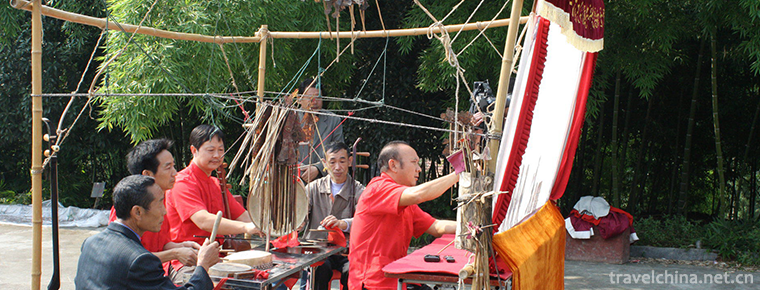
-
Mingyue Mountain
Mingyue Mountain: National tourist resorts, National Scenic spots, national AAAAA tourist attractions, National Forest parks, national geological parks, National Natural heritage, home of hot springs .
Views: 214 Time 2018-12-08 -
Liao Zhai City
Liaozhai City was invested and built by Pujiazhuang, Zichuan. It is a large-scale famous garden scenic area with gardens as its manifestation and Liaozhai stories as its theme.
Views: 151 Time 2019-01-30 -
Nanchong Xishan Scenic Area
Nanchong Xishan Scenic Spot, located in the west of Shunqing City, is a provincial scenic spot and a national 4A-level tourist attraction. It is the destination of "Three Kingdoms Cultural Explor.
Views: 203 Time 2019-02-25 -
The Story of Barragan
Stories of witty figures of the Mongolian people in China. Long-term spread in Inner Mongolia, Xinjiang and other Mongolian areas. The protagonist Balagan Cang is the representative of the working peo.
Views: 231 Time 2019-04-02 -
Daur traditional Hockey
Daur's traditional hockey sport is called "Bei Kuo Taj Ke Bei" in Daur language. Bei Kuo refers to a bat. The Daur bat is made by grinding oak wood with curved roots and straight branches. I.
Views: 119 Time 2019-04-22 -
Gold lacquer inlay decoration technique
Gold lacquer inlay decoration technology, Beijing local traditional handicraft, one of the national intangible cultural heritage..
Views: 254 Time 2019-05-07 -
Tune in the sea
Linhai Ci Tune, also known as Taizhou Ci Tune, Talent Ci Tune and Xianhe Tune, is developed from Nanci, Kunqu and Taizhou local folk minor. It is one of the folk songs of Taizhou, Zhejiang Province. I.
Views: 245 Time 2019-05-13 -
Lisu Folk Songs
Lisu people advocate singing in tune. In the multi-voice unaccompanied chorus of Lisu people, the three major tunes of Lisu folk songs are "swing time", "excellent leaf" and ".
Views: 99 Time 2019-06-17 -
Prince Wuwuwu quarrel
Prince Wujiaozi is one of the unique traditional folk dances in Beijing. It integrates entertainment, fitness and performance. Wujiaozi has a strong style, rough style, relaxation and generosity. Part.
Views: 130 Time 2019-06-18 -
conjuring tricks
Conjuring tricks is one of the traditional Chinese acrobatics. Performers use agile methods to create audiovisual illusions, performing various objects, animals or water and fire and other rapid incre.
Views: 96 Time 2019-07-01 -
Jinhua Alsophila Nature Reserve
Jinhua Alsophila spinulosa nature reserve is a provincial nature reserve approved by Sichuan Provincial People's Government in 1987. In sifangjinggou, Jinhua Township, 48 kilometers southwest of Rongxian City.
Views: 155 Time 2020-10-15 -
Guangan Airlines
There is no airport in Guang'an, but there are many airports around it. At the same time, Guang'an terminal building of Chongqing Jiangbei International Airport has been built in the urban area. Guang'an is 110 kilometers away from Chongqing Jian.
Views: 170 Time 2020-12-19

